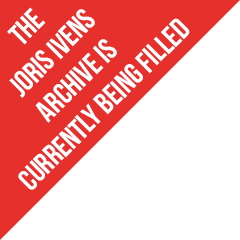

The European Film Academy (EFA) honors Joris Ivens, The Bridge (1928) and the vertical-lift bridge in Rotterdam (Koningshaven Bridge) by including it as Treasures of European Film Culture. It is for the first time that a Dutch filmmaker and location is included in this growing list of in the meanwhile 49 European locations in 24 countries, which or of extreme importance for the European film culture. According to the EFA these places of historical value need to be maintained and protected not just now but also for generations to come.
Famous locations of this list are the great staircase in Odessa from Eisensteins’ Pantserkruizer Potemkin(1925), the Trevi Fontain in Rome (La Dolce Vita, 1960) and the Notting Hill Bookshop (Notting Hill, 1999) in Londen.
See: https://www.europeanfilmacademy.org/activity/koningshaven-bridge-rotterdam-netherlands/
With The Bridge Joris Ivens freed the filmcamera, because he brought to live a 'dead iron machine' without a fixed tripod, without a script, without actors, filming spontanously, climbing and performing break neck tricks on the beams of the lift bridge. This lift bridge was opened at the end of 1927 and within a few weeks Ivens alerasdy started filming with a Kinamo hand held 35 mm. film camera. This groundbrealing film presented The Netherlands as a new, modern country, no longer with the folkoristic images of wind mills and Volendam puff pants. This short film conquered immediately the avant-garde cinema theaters of Europe. With The Bridge Ivens became worldwide one of the pioneers of a new film language. He discovered himself during the editing the effects of rythm in film, of directions and movements, and called his film 'My Mondrian', with a game and balance of opposites. He also was amazed by the effects of perceptual psychology: it is possible to create a world on its own on the cinema screen. The simple narrative looked very realistic: a train from the south is arriving at the railbridge, but has to stop because the liftbridge opens for passing boats, and only after the bridge is closed again the train can continue its track to the north. It wasn't realistic, but an invented drama: ‘There is also such thing as a train timetable, preventing trains to stop', wrote the journal of train drivers. For Ivens this result was quintessential for the start of his film career. From that moment on he knew that he could create film art with a world on its own.
Joris Ivens (Nijmegen 1898-Parijs 1989) grew up in the family of Kees Ivens, an entrepreneur in photo equipment and his grandfather Wilhelm Ivens, a prolific photograper. In these three generations one can notice the for The Netherlands unique organic transformation from photography (the art of the 19th century) to film art (the art of the 20th century).
Since 1997 the Joris Ivens Archives are established in his birthplace Nijmegen which is managed by the European Foundation Joris Ivens in the Regionaal Archief Nijmegen.
Award and decorations Joris Ivens
1955 Ivens ontvangt de Wereld Vredesprijs in Helsinki.
1957 Wint een Gouden Palm op het filmfestival van Cannes en een Golden Gate Award in
San Francisco met de film La Seine a rencontré Paris (De Seine ontmoet Parijs).
1966 Zilveren Leeuw op filmfestival van Venetië voor Pour le Mistral
1967 Ontvangt de Internationale Lenin Prijs voor Wetenschap en Cultuur in Moskou.
1978 Het Royal College of Art in Londen verleent Ivens een ere-doctoraat.
1984 Wordt benoemd tot Commandeur van de Legion d`Honeur (Franse ridderorde) door
de Franse president Mitterand.
1985 Ontvangt Het Gouden Kalf (Hoofdprijs op het Nederlands Film Festival in Utrecht)
uitgereikt door minister Brinkman.
Wordt geridderd tot Groot Officier van de Republiek Italië.
Ontvangt de gouden medaille voor "grote verdiensten voor de Schone Kunsten" van de
Spaanse koning Juan Carlos.
1987 Ontvangt de "Che Guevarra Prijs" in Cuba.
1988 Krijgt uit handen van Gina Lolobrigida de Gouden Leeuw voor zijn gehele oeuvre op
het internationale filmfestival van Venetië.
Wordt door burgemeester Ien Dales benoemd tot ereburger van zijn geboortestad
Nijmegen.
1989 Wordt tot Ridder in de Orde van de Nederlandse Leeuw gedecoreerd door koningin
Beatrix.
Sterft in Parijs op 28 Juni.
Marceline Loridan-Ivens (zijn vrouw) wint een Felix ("de Europese Oscar") voor Ivens`
complete oeuvre en in het bijzonder voor de laatste film die ze samen maakten Une
Histoire de Vent (Het verhaal van de wind).